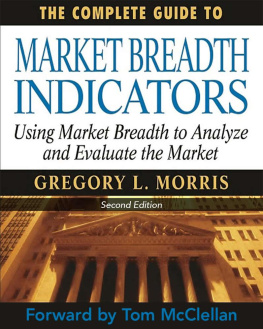The Difference between Daily and Weekly Breadth Data.
List of Charts, Tables, Figures
Chart 1-1-Advances, Declines, and Unchanged, all as a percentage of total issues
Chart 1-2 New Highs and New Lows as a percentage of total issues
Chart 1-3 Up Volume and Down Volume as a percentage of total issues
Chart 3-1-Advances and Declines
Chart 3-2 Advances and Declines adjusted for Total Issues
Chart 3-3 New Highs and New Lows
Chart 3-4 New Highs and New Lows adjusted for Total Issues
Chart 3-5 Up Volume and Down Volume
Chart 3-5b Up Volume and Down Volume plotted using semi-log scaling
Chart 3-6 Up Volume and Down Volume adjusted for Total Volume
Chart 4-1-Advances minus Declines smoothed by 21-days
Chart 4-2 Advances minus Declines exponentially smoothed by 3 days
Chart 4-2b Advances minus Declines exponentially smoothed by 3 days with +1000-and -1000-zones
Chart 4-3 Advance Decline 10-and 30-smoothed difference - Mamis
Chart 4-4 Advance Decline Overbought Oversold
Chart 4-5 Advance Decline Overbought Oversold with levels at +400, +150, -150, and -400
Chart 4-6 Advance Decline technique - Lindsay
Chart 4-7 Advance Decline - Kinsman
Chart 4-8 Plurality Index
Chart 4-9 Plurality Index with new zones
Chart 4-10-Fugler 3-day Advance Decline technique
Chart 4-11-Advance Decline Line
Chart 4-12 Advance Decline Line non confirmation - 1987
Chart 4-13 Advance Decline Line non confirmation - 1998
Chart 4-14 Advance Decline Line divergences
Chart 4-15 Advance Decline Line - weekly
Chart 4-16 Momentum Index - Weinstein
Chart 4-17 1% Advance Decline - Swenlin
Chart 4-18 Eakle Advance Decline Index
Chart 4-19 Eakle Advance Decline Index - weekly
Chart 4-20-Advance Decline Line Normalized 5 days
Chart 4-21-Advance Decline Line Normalized - 21-days
Chart 4-22 Bolton Advance Decline Line
Chart 4-23 Bolton Advance Decline ratio - 21-day smooth
Chart 4-24 Advance Decline Line adjusted for total issues
Chart 4-25 Big Movers Only - 35%
Chart 4-26 Big Movers Only - 50%
Chart 4-27 Advance Decline Line Oscillator
Chart 4-28 Advance Decline Line Oscillator - Appel
Chart 4-29 Absolute Breadth Index - 50-day smooth
Chart 4-30-Absolute Breadth Index - 21-day smooth with 300-and 1100-levels
Chart 4-31-Absolute Breadth Index - 21-day with 250-and 600-levels
Chart 4-32 Absolute Breadth Index Adjusted by Total Issues - 21-day smooth with 10-and 30-levels
Chart 4-33 McGinley Advance Decline (AD) Power
Chart 4-33b Weekly McGinley AD Power
Chart 4-34 Coppock Breadth Indicator
Chart 4-35 Haurlan Index Short-term
Chart 4-36 Haurlan Index Intermediate-term
Chart 4-37 Haurlan Index Long-term
Chart 4-38 McClellan Oscillator
Chart 4-39 McClellan Summation Index - Traditional
Chart 4-40-McClellan Summation Index - Miekka
Chart 4-41-McClellan Summation Index - Swenlin
Chart 4-42 McClellan Summation Index - Pring
Chart 4-43 Merriman NYSE Breadth Model
Chart 4-44 Swenlin IT Breadth Momentum Oscillator
Chart 4-45 Swenlin Trading Oscillator Breadth
Chart 4-46 Zahorchak Method - daily
Chart 4-47 Zahorchak Method weekly
Chart 4-48 Zahorchak Alternate daily
Chart 4-49 Zahorchak Alternate weekly
Chart 4-50-Zahorchak Alternate special - weekly
Chart 5-1-Advance Decline Ratio 1965 - 2004
Chart 5-2 Advance Decline Ratio 1996 - 2004
Chart 5-3 Breadth Thrust
Chart 5-4 Breadth Thrust with simple 10-day smooth
Chart 5-5 Breadth Thrust with exponential 8-day smooth
Chart 5-6 Breadth Thrust Continuation
Chart 5-7 Duarte Market Thrust - weekly
Chart 5-8 Eliades Sign of the Bear
Chart 5-9 Hughes Breadth Momentum Oscillator
Chart 5-10-Hughes Breadth Momentum % Oscillator
Chart 5-11-Panic Thrust
Chart 5-12 STIX Short-Term Trading Index
Chart 5-13 STIX with 10-day smooth
Chart 6-1-Schultz Advances / Issues Traded Ratio
Chart 6-2 Schultz Advance / Total Issues - smoothed
Chart 6-3 Advance Decline Divergence Oscillator
Chart 6-4 Advance Decline Diffusion Index
Chart 6-5 Breadth Climax
Chart 6-6 Declining Issues TRIX
Chart 6-7 Advancing Issues TRIX
Chart 6-8 Disparity between NYSE Index and Advance Decline Line
Chart 6-9 Disparity Index
Chart 6-10-Walter Heiby Dynamic Synthesis
Chart 6-11-Walter Heiby Dynamic Synthesis as a percentage of Total Issues
Chart 6-12 Walter Heiby Dynamic Synthesis Indicator
Chart 6-13 Unchanged Issues
Chart 6-14 Unchanged Issues 21-day smooth
Chart 6-15 Unchanged Issues as a percentage of Total Issues
Chart 6-15b Unchanged Issues / Total Issues - 1987
Chart 6-16 Velocity Index
Chart 7-1-New Highs New Lows 21-day smooth
Chart 7-2 New Highs New Lows % Total Issues - Hayes
Chart 7-3 New Highs New Lows Line
Chart 7-4 New Highs New Lows Line 21day smooth
Chart 7-5 New Highs & New Lows Oscillator
Chart 7-6 New Highs & New Lows Oscillator - Appel
Chart 7-7 New Highs New Lows - Morris
Chart 7-8 High Low RSI
Chart 7-9 High Low Stochastic
Chart 7-10-New Highs New Lows Ratio 21-day smooth
Chart 7-11-New Highs New Lows Ratio 10-day smooth
Chart 7-12 New High New Low - Cohen
Chart 7-13 New Highs New Lows Ratio - Merrill
Chart 7-14 Weekly New Highs - Hayes
Chart 7-15 New Highs - Hayes
Chart 7-16 New Highs & New Lows Cross
Chart 7-17 New High New Low Cross 10-day smooth
Chart 7-18 New Highs New Lows - Burk
Chart 7-19 New Highs % Total Issues
Chart 7-20-New Highs % Total Issues Rate of Change
Chart 7-21-Weekly New Highs New Lows - Hayes
Chart 7-22 New Lows % Total Issues
Chart 7-23 New Lows % Total Issues Rate of Change
Chart 7-24 High Low Logic Index
Chart 7-25 High Low Logic Index - weekly
Chart 7-26 High Low Logic - Appel
Chart 7-27 Low High Logic Index
Chart 7-28 High Low Validation Index
Chart 8-1-Up Volume 21-day smooth
Chart 8-2 Up Volume 10-day smooth
Chart 8-3 Up Volume 21-day Detrended
Chart 8-4 Down Volume 21-day smooth
Chart 8-5 Down Volume 21-day Detrended
Chart 8-6 Changed Volume - 21-day smooth
Chart 8-7 Up Volume and Down Volume
Chart 8-8 McClellan Oscillator - Volume
Chart 8-9 McClellan Summation - Volume







